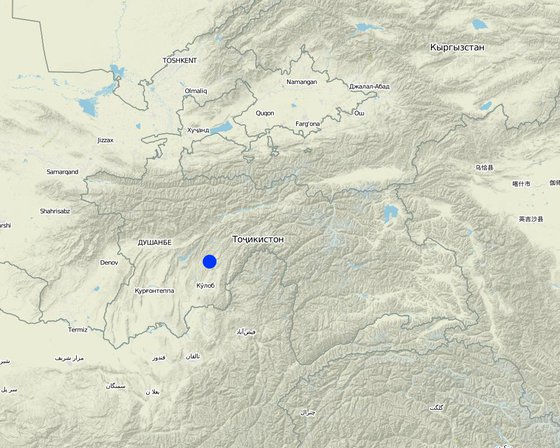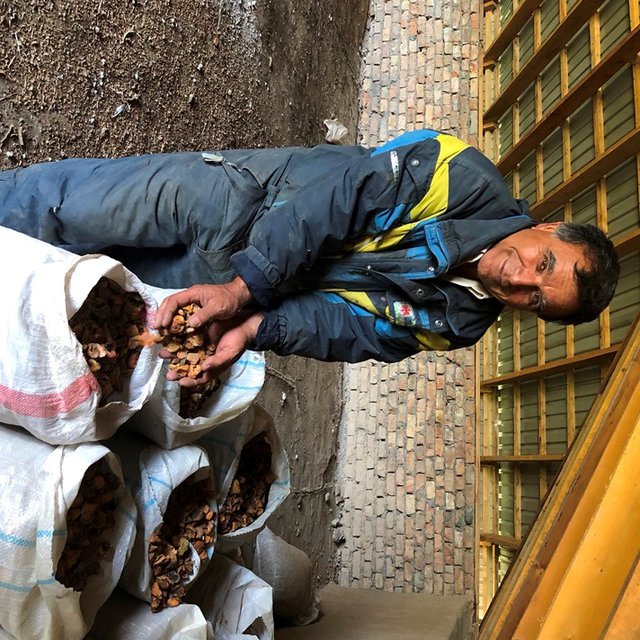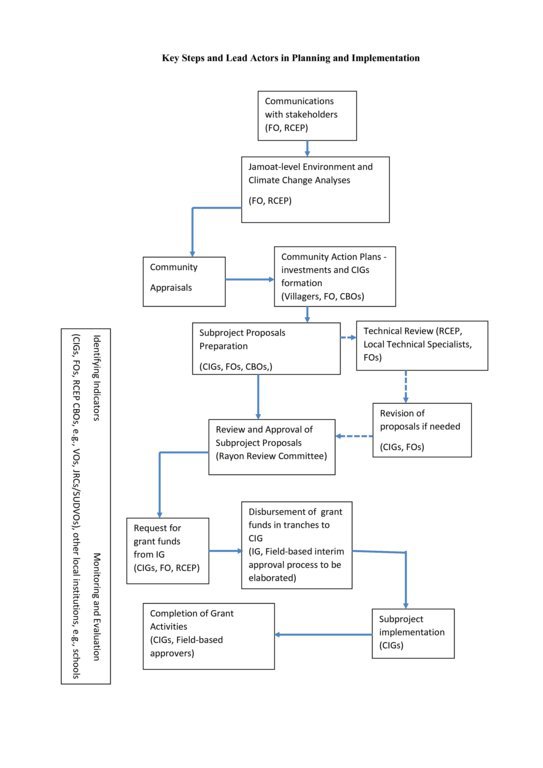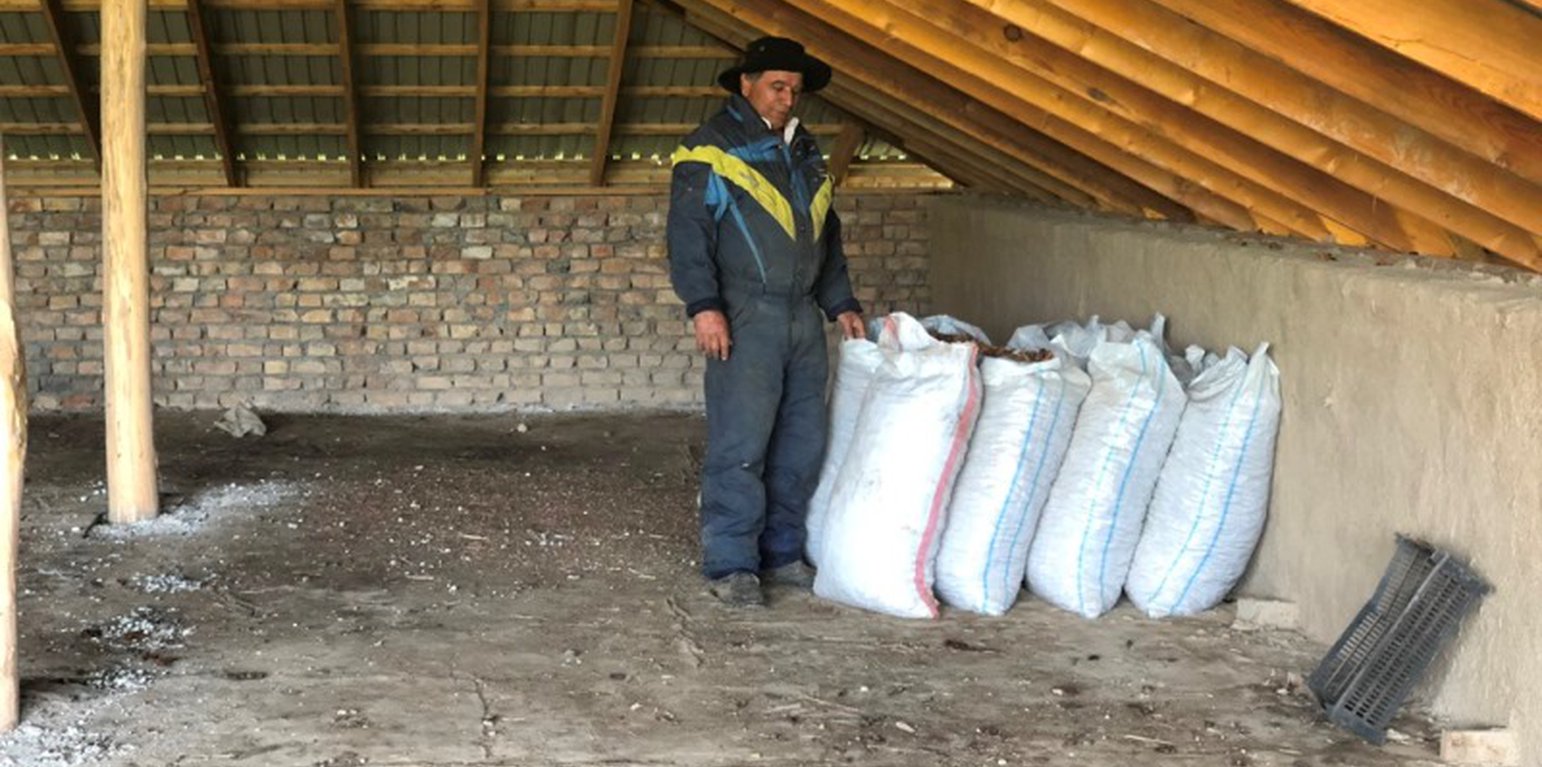Saving harvest of the orchards through drying
(Tajikistan)
Пешгирии талафоти мева таввасути қоқкунӣ
Description
Gardeners in different ways store apples, pears, pomegranates, grapes and nuts for winter, but the main part of the harvest used for the animals. Proposed approach help land users to save all the harvest using drying methods.
People usually used fresh fruits and store it in a different way for the winter. Therefore, to preserve freshness and juiciness, apples and granates reserved them in jars.There are many opportunities for drying fruits in Safedshahrak village of Lohuti jamoat. The village has more than 10 hectares of orchards. The village is located far from the district center at a distance of 18 km, in the north-east part of the district and at an altitude of 1300 m. The climate is humid and with abundant rainfall. Local people are mainly engaged in growing potatoes, gardening and livestock breeding. Industrial enterprises do not function in the district. A small number of women study at Medical College and a vocational technical school or attend a special high and secondary schools in Dushanbe to get any skills. However, working places are only available in the central district hospital and general education schools for 5-6% of the total number of qualified women.
The project provides small-scale grants at the village level for groups of households to implement rural production and land management investments, as well as related small-scale infrastructure investments.Villages will prioritize investments based on a fixed budget for each type of rural investment, determined by the number of households
The CIG established in Safedshahrak village, which consisted of 25 members, and they recognize their work on drying fruits as an advantage in the first place. With the support of the project, the CIG was purchased and installed tools and equipment for drying fruit, and put production into operation.
Abdukodir Gozaev, a head of CIG, made all preparations for the construction of a warehouse for drying fruits, organized work on harvesting and drying fruit according to the plan. As a result, the rural people collected 60 tons of fresh fruit, which were dried. There are 3.5 tons of dried apples, 3.5 tons of cherries, 1 ton of rose hips and 0.5 tons of plums in the group's warehouse. Collected products were sold, and the sale profit was TJS 21950 (2,488$). The CIG head paid to the population from the funds received after the sale. In the future, he intends to prepare special boxes and sell them with packed dried fruit. This type of activity will give the opportunity to adapt their products to market requirements
Location

Location: Jamoat Lohuti, Safedshahrak village, Kulob Region, Khovaling District, Tajikistan
Geo-reference of selected sites
Initiation date: 2016
Year of termination: 2017
Type of Approach
-
traditional/ indigenous
-
recent local initiative/ innovative
-
project/ programme based

The head of CIG with their production (Kamolidin Abdulloev)
Approach aims and enabling environment
Main aims / objectives of the approach
Supporting gardeners to improve the management of the orchards and to save their harvest using drying fruit approach, by this way to raise the household income
Conditions enabling the implementation of the Technology/ ies applied under the Approach
-
Social/ cultural/ religious norms and values: None
-
Availability/ access to financial resources and services: None
-
Institutional setting: None
Conditions hindering the implementation of the Technology/ ies applied under the Approach
-
Social/ cultural/ religious norms and values: People usually used fresh fruits or stored apples, pears, grapes and nuts for winter only as the juice and did not drying them. Duirng the season gardenners lost thousands tons of the fruits that were the main part of their harvest
As the result of the project there were appeared an opportunity to save all the harvest from their orchards and additionaly have income from that
-
Availability/ access to financial resources and services: Gardeners used only fresh fruits and did not use the main part of their harvest as a result, the rural people collected 60 tons of fresh fruit, which were dried. There are 3.5 tons of dried apples, 3.5 tons of cherries, 1 ton of rose hips and 0.5 tons of plums in the group's warehouse. Collected products were sold and have a good profit. The CIG head paid to the CIG Members (local Land Users) from the funds received after the sale. In the future, he intends to prepare special boxes and sell them with packed dried fruit. This type of activity will give the opportunity to adapt their products to market requirements.
-
Institutional setting: As the result of the project established the Common Interest Group that will manage and maintain the approach in future
-
Knowledge about SLM, access to technical support: Lack of knowledge on SLM approaches and technologies There was organised different type of SLM relative trainings on behalf of the project during the approach implementation
Participation and roles of stakeholders involved
Stakeholders involved in the Approach and their roles
| What stakeholders / implementing bodies were involved in the Approach? |
Specify stakeholders |
Describe roles of stakeholders |
| local land users/ local communities |
Gardeners (CIG Members) |
Local land users prioritized investments based on a fixed budget for each type of rural investment determined by the number of households. Within a plan of action, participants decided on the allocation of investments to groups of households using rules that limit the funding for any one household. |
| SLM specialists/ agricultural advisers |
Reprezentatives from the project parners and government institutions |
Reprezentaives from the facilitating organisations and professors (as TOT trainers) from the Institutions and academies involved during the trainings |
| local government |
Hukumat and jamoat reprezentatives |
Jamoat representatives were involved in Participatory Rural Appraisal (PRA) that was used as the main pre-assessment mechanism to analyze the socio-economic and environmental situation in the selected pilots, The RRC(Rayon Review Committee) will consider the combination of proposed sub-projects within the overall context of the rayon and project. The committee will review and accept proposals that meet project guidelines and provide clearance to the IG for the release of project funding to the accounts of relevant CIGs. |
Involvement of local land users/ local communities in the different phases of the Approach
none
passive
external support
interactive
self-mobilization
planning
Project beneficiaries (CIG Members) interviewed and consulted during the social assessment conducted in the project design process which then influenced project approaches.
implementation
During the Participatory and Community Action Planning Villagers (CIG Members) made grant allocation decisions. After the supporting CIGs proposals, they had managed grant funds and purchased needed materials and products individually
monitoring/ evaluation
active participation of the local land users during the monitoring process
Flow chart
Step by step implementation and key actors in the process

Author: ELMARL POM
Decision-making on the selection of SLM Technology
Decisions were taken by
-
land users alone (self-initiative)
-
mainly land users, supported by SLM specialists
-
all relevant actors, as part of a participatory approach
-
mainly SLM specialists, following consultation with land users
-
SLM specialists alone
-
politicians/ leaders
Decisions were made based on
-
evaluation of well-documented SLM knowledge (evidence-based decision-making)
-
research findings
-
personal experience and opinions (undocumented)
-
Project initial phases
Technical support, capacity building, and knowledge management
The following activities or services have been part of the approach
-
Capacity building/ training
-
Advisory service
-
Institution strengthening (organizational development)
-
Monitoring and evaluation
-
Research
Capacity building/ training
Training was provided to the following stakeholders
-
land users
-
field staff/ advisers
Form of training
-
on-the-job
-
farmer-to-farmer
-
demonstration areas
-
public meetings
-
courses
Subjects covered
Financial management, reporting, subproject/approach management and technical, SLM reletive trainings
Advisory service
Advisory service was provided
-
on land users' fields
-
at permanent centres
Jamoat (agronomist, ecologist and other specialists) advise CIG Members
Institution strengthening
Institutions have been strengthened / established
-
no
-
yes, a little
-
yes, moderately
-
yes, greatly
Describe institution, roles and responsibilities, members, etc.
The Common Interest Groups formed in the villages on behalf households and enhanced their knowledge. And the project provides small-scale grants at the village level for groups of households (CIG) to implement rural production and land management investments, as well as related small-scale infrastructure investments. Villages will prioritize investments based on a fixed budget for each type of rural investment, determined by the number of households.
Type of support
-
financial
-
capacity building/ training
-
equipment
Further details
Project-financed grants to CIGs for each investment under categories of rural production and land management investments, as well as related small-scale infrastructure investments that will not exceed US$7,000 and will require a match of 25% in beneficiary contributions which may be in cash or in-kind
Monitoring and evaluation
environmental aspects, management of the investments, and other social and economic issues
Financing and external material support
Annual budget in USD for the SLM component
-
< 2,000
-
2,000-10,000
-
10,000-100,000
-
100,000-1,000,000
-
> 1,000,000
Precise annual budget: n.a.
GEF/PPCR through WB
The following services or incentives have been provided to land users
-
Financial/ material support provided to land users
-
Subsidies for specific inputs
-
Credit
-
Other incentives or instruments
Financial/ material support provided to land users
The project financed investments in three categories that are expected to improve household assets and sustainable land management, and build climate resilience,
The CIGs prepared proposals for investments that included basic data on beneficiaries and funding requirements, the objectives and the issue/opportunity that is being addressed, description of the investment and activities (including a work plan and budget), summary of environmental, economic and social feasibility and sustainability measures, and a brief monitoring and evaluation plan.
Project financed grants to the CIGs that not exceed US$7,000 and will require a match of 25% in beneficiary contributions which may be in cash or in-kind. The grants disbursed in tranches directly to beneficiaries or groups to their own bank account
Other incentives or instruments
Study tours, competition farmer to farmer
Impact analysis and concluding statements
Impacts of the Approach
No
Yes, little
Yes, moderately
Yes, greatly
Did the Approach empower local land users, improve stakeholder participation?
As a result, the rural people collected 60 tons of fresh fruit, which were dried. There are 3.5 tons of dried apples, 3.5 tons of cherries, 1 ton of rose hips and 0.5 tons of plums in the group's warehouse. Collected products were sold, in the local market. Local land users paid to their members from the funds received after the sale.
Did the Approach improve knowledge and capacities of land users to implement SLM?
A big bunch of the training and meetings had been organized with the CIG (local land users) that will give them an opportunity to manage and maintain on hand approach
Main motivation of land users to implement SLM
-
increased production
-
increased profit(ability), improved cost-benefit-ratio
-
reduced land degradation
-
reduced risk of disasters
-
reduced workload
-
payments/ subsidies
-
rules and regulations (fines)/ enforcement
-
prestige, social pressure/ social cohesion
-
affiliation to movement/ project/ group/ networks
-
environmental consciousness
-
customs and beliefs, morals
-
enhanced SLM knowledge and skills
-
aesthetic improvement
-
conflict mitigation
Sustainability of Approach activities
Can the land users sustain what hat been implemented through the Approach (without external support)?
The local land user from the beginning did all the activities individually after the training that was provided by the project. made grant allocation decisions, also CIGs managed grant funds and bought inputs. Maintaining actions are in place
Conclusions and lessons learnt
Strengths: land user's view
-
The head of CIG is the specialist and knows all the details of the activity that help them better manage and maitain an approach
-
The building and the local materials that was used during the project belonged to the CIG members and it gives them opportunity to implement such project
Strengths: compiler’s or other key resource person’s view
-
Being in a group(CIG), gives opportunity to do desicions together and expanding approach in the plan
-
Capacity building events that was organised during the approach, new technologies, new knowledges and so on
-
Good cooperation with the jamoat
Weaknesses/ disadvantages/ risks: land user's viewhow to overcome
Weaknesses/ disadvantages/ risks: compiler’s or other key resource person’s viewhow to overcome
-
Market, value chance, preparation of the business plans and other reletive knowledges they need
Other coming projects or local hukumat needs to support them
References
Date of documentation: July 6, 2018
Last update: July 29, 2018
Resource persons
-
Murod Ergashev (soil_m@rambler.ru) - SLM specialist
Full description in the WOCAT database
Documentation was faciliated by
Institution
- Committee for Environment Protection of Tajikistan (Committee for Environment Protection of Tajikistan) - Tajikistan
Project
- Environmental Land Management and Rural Livelihoods (ELMAR)
Key references
-
ELMARL Annual Report 2017:
Links to relevant information which is available online






